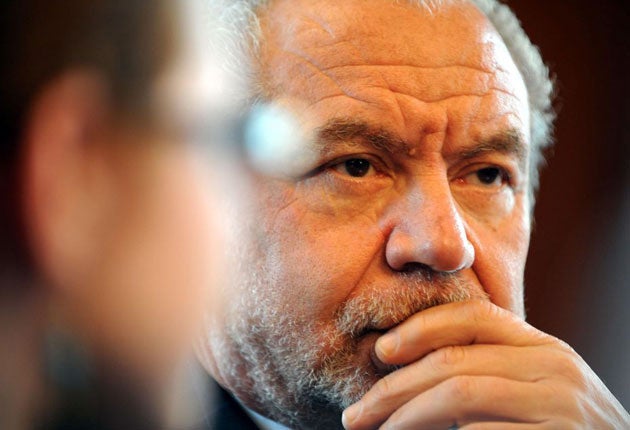Last Night's TV: 24 Hours in A&E/Channel 4<br />The Apprentice/BBC1

With "structured reality" shows like The Only Way is Essex making all the noise now (and taking some of the Baftas) it's perhaps worth remembering that all documentaries structure reality – it's just that the traditional kind does it after the event rather than before. Take 24 Hours in A&E, for example, Channel 4's observational series about King's College Hospital emergency room, which on the face of it cedes pretty much all of its construction to contingent life. The structure, notionally at least, is simply one damn thing after another, and the principal characters are whoever gets wheeled through the swing doors on a stretcher or – as in last night's rather dramatic episode – staggers through the door, having been shot in the face.
You may be reassured to know that if this happens you don't have to wait in the queue along with everyone else. In fact you go to number one with a bullet, a priority which has something to do with your injuries, but is also connected to the fact that it's not unknown for disappointed shooters to follow their victims into A&E rooms to have another go. One of the first calls the attending doctors make is to the police, so armed officers can come down and ensure that your examination room isn't turned into a shooting gallery. No plotting that kind of development, you might say, and you'd be right. It's part of 24 Hours' appeal that, like the doctors themselves, you just don't know what's going to happen next.
Within the constraints, though, there's quite a lot of artful shaping going on. Last night's main case – a young boy called Kofi, who'd been shunted 20ft through the air after what the paramedic described as "pedestrian versus car" – didn't appear to have anything in common with another featured admission, a 77-year-old man called Roger, who rather touchingly bored on about his rock'n'roll career with The Tornados ("I shared a hamburger with Presley"). And not only was the comedy of his nostalgia neatly done, steering just this side of meanness, but his memories of South London "cosh boys" nudged you into packaging all the disparate incidents of the night – the stabbings and bottlings and youthful catastrophe – into a larger consideration of social change.
Not that it ever feels like that. What 24 Hours' fixed cameras mostly give you is human nuance. Nadine, a 16-year-old hairdresser, came in with a nasty cut on her cheekbone, having been glassed by some thug who objected to her objections to his advances. She wept and shrieked and worried about the scar but then, once the stitches had been put in, she started flirting with the doctor, hip-grinding around the ward as if she was back in the nightclub. Waiting to be seen for some minor injury, a man heaved a great sigh when the call about Kofi came in – not unfeeling really, but just wearily aware that his wait had just been extended. And then there was Roger, assiduously filling in anyone unwise enough to show an interest with the minutiae of his past celebrity ("I was the actual favourite cocktail pianist of the President of Mexico at the time...")
Next door Kofi was "fighting for his life" – in a tired cliché that didn't really do justice to what you were watching. Kofi was sleeping on the job, frankly, while a team of 15 medical personnel did the fighting for him, deploying an arsenal of medical devices and drugs which meant that they eventually won. At which point you became aware of another subtle piece of architecture. In most of the cases, retrospective interviews are spliced together with footage of treatment, so that a happy "after" can take the edge off the often gruesome "before". In this case you only saw Kofi back to health right at the very end. They wanted us to worry that he might not make it.
Last night's Apprentice task kicked off in the British Museum. "Behind me is a statue of Aphrodite, goddess of love and beauty," growled Lord Sugar, "... and beauty is a massive business." Not exactly a Keatsian response to the glories of classical sculpture, but then Lord Sugar didn't get that personalised numberplate on his Bentley by maundering on about truth and unravish'd brides of quietness. If he hadn't settled on electronics, he told his epigones, he would have gone into the beauty trade because the margins are colossal. The secret here was to push treatments (very low costs, very high profits) rather than products, something both teams failed to identify. Susan earned some feathers in her cap by getting so giddily excited about a spray-tanning treatment that she secured it over a competing bid from the other team – and then lost all her feathers again because she'd wildly overestimated her ability to sell instant prettiness potion to the careful shoppers of Birmingham. "This is really, really unfair," she said when it was pointed out to her that she'd cocked up, but by the time she'd reached the boardroom her trembling lower lip had stiffened into an ominously vengeful pout. Fortunately her team scraped it anyway – and it was the other side who had to trudge off to the Sadsack Café. "I believe we are all equally responsible for the failure of this task," said Felicity, the project leader, heroically opting to lead from somewhere in the middle of a dense and protective huddle of footsoldiers. Equally responsible or not, she alone got Lord Sugar's digital redundancy notice.
Subscribe to Independent Premium to bookmark this article
Want to bookmark your favourite articles and stories to read or reference later? Start your Independent Premium subscription today.

Join our commenting forum
Join thought-provoking conversations, follow other Independent readers and see their replies